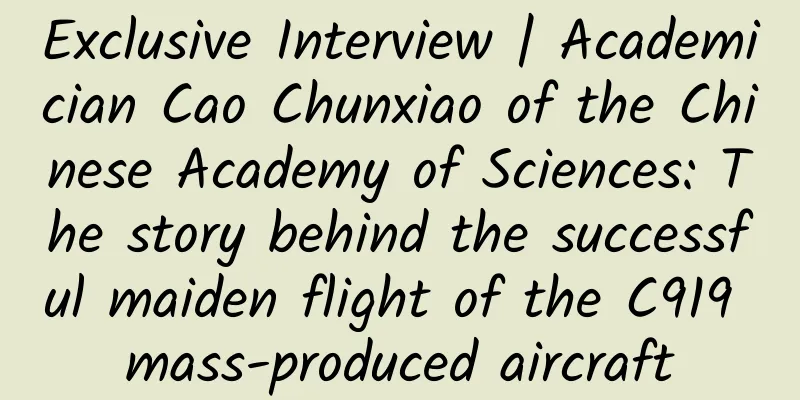Exclusive Interview | Academician Cao Chunxiao of the Chinese Academy of Sciences: The story behind the successful maiden flight of the C919 mass-produced aircraft

|
The C919 passenger aircraft, which will soon be delivered to China Eastern Airlines, has made its maiden flight successfully. What is the special significance of this successful maiden flight? How far is it from being put into operation? Cao Chunxiao, an academician of the Chinese Academy of Sciences, explains to you. Written by reporter Duan Ran (intern reporter) Photo and text editor Chen Yongjie New Media Editor/Li Yunfeng |||| ◈ ◈ ◈ From the first flight to operation: I will explore Beijing Science and Technology Daily: How do you evaluate the significance of the successful maiden flight of the C919 mass-produced aircraft? Cao Chunxiao: About five years ago, also in May, I participated in the test flight of the C919 prototype. At that time, the C919 project was at a very critical moment. The prototype's first flight was of great significance. After the first flight, various tests were required. Only through the flight and verification of multiple subjects could the entire project reach its current state. In comparison, this is the maiden flight of a model that will soon be delivered to users, which has another layer of meaning: that is, C919 is an important layout before the product is put on the market, and the product is about to be delivered and commercialized. China Eastern Airlines has purchased the first batch of five C919s. Among these five, we will test the first aircraft to be delivered to the user to verify whether the product delivered to the user truly meets the corresponding needs. Just like aircraft engines, engine test runs must be carried out before mass production but before delivery. At this stage, the manufacturer and the user will arrange the test flight project according to the specific agreement to jointly complete the acceptance. Of course, the work after the first flight of the mass-produced aircraft will not be as complicated as the first flight of the prototype. However, the flight test before delivery and acceptance is still very important. After all, this is the first step towards the commercialization of C919. It will be put on the market and put into route operation in the future. Overall, the success of this first flight is still a very critical interim achievement. This shows that after the past five years of prototype flight test work, the various indicators of C919 have reached a state that can be delivered for use. Once the subsequent test flight subjects are passed, the first aircraft can be truly delivered to the user. I think this first flight is an important milestone in the commercialization and marketization of C919. Beijing Science and Technology Daily: From the successful maiden flight to the official realization of commercial flight, what procedures still need to be completed in the C919 project? Cao Chunxiao: The main problem we are facing now is that the C919 needs to obtain the airworthiness certificate from relevant domestic and international aviation authorities. Of course, considering the complex international situation we are facing now, there is still a long way to go to obtain airworthiness certificates from other countries. ◈ ◈ ◈ Self-reliance: The fragrance of plum blossoms comes from the bitter cold Beijing Science and Technology Daily: The C919 civil airliner is a market-oriented product, and many of its core suppliers are foreign companies. Will there be a need to increase the localization rate in the future? Cao Chunxiao: Of course. Although large civil airliners are complex systemic projects and do not require all parts to be domestically produced, key core parts and materials still need to be domestically produced. ▲Current suppliers of C919 components (Photo from "52 Hertz Laboratory") Especially in the engine part, while the C919 project is introducing advanced foreign engines, our domestically produced Yangtze-1000A engine is also being developed at a rapid pace, and the progress is relatively smooth. Improving the localization rate of C919 is not a one-day job, it requires a process, but this process needs to be accelerated. Once the key core components cannot be launched by our own products, the entire project may face the embarrassing situation of being "choked" by others in the international arena, and related work may not be able to move forward. Currently, the C919 uses the LEAP-X1C turbofan engine jointly developed by the United States and France. This introduction is very necessary due to the market demand for civil aviation passenger aircraft. But at the same time, we must have our own suppliers. On the one hand, we can rely on our products to gain bargaining power when negotiating with international manufacturers. On the other hand, once extreme situations such as international supply channels being blocked occur, there is no need to worry about problems with the entire production supply chain. At present, with the continuous deepening of flight test work, the C919 project is constantly striving to increase the localization rate. Especially in the face of the current complex international situation, it is even more necessary to base on the domestic market and accelerate the process of localization. In fact, the same is true for other domestic industries, but the problem of localization in the aviation industry is more prominent, because of its high technological content, the difficulty of the entire research and production is very high. In this case, we should do a good job in independent research and development and really come up with our own things. Beijing Science and Technology Daily: Before the C919 project was launched, what experience had my country accumulated in the development of large civil airliners? Cao Chunxiao: Many achievements are the result of continuous accumulation based on existing results and experiences, and further improvement on the original basis, generating new ideas based on new development needs - this is an inevitable process. The same is true for the C919 project. The R&D experience of this project comes to a certain extent from the Y-10 project of that year, namely the Project 708 led by Shanghai (Editor's note: On August 21, 1970, with the approval of Premier Zhou Enlai, the National Planning Commission and the Military Commission's National Defense Industry Leading Group approved the "Report on the Trial Production of Transport Aircraft in Shanghai" proposed by the Aviation Industry Leading Group, and issued a task to Shanghai to develop large passenger aircraft and their engines, and included it in the national plan. At this point, the Y-10 passenger aircraft project, code-named "Project 708", was officially launched.) I personally also directly participated in this project. My professional field is titanium alloy materials, so I participated a lot in the development of the Y-10 engine, the WS-8, and cooperated with relevant units in Shanghai and other places to be responsible for the research and development of titanium alloy materials. The WS-8 engine has many parts such as blisks and blades made of titanium alloy. I was responsible for a lot of research work such as titanium alloy forging processing. Of course, the blades faced many technical difficulties, such as how to ensure the uniform metallographic structure of the forgings. This technical detail determines the performance of the engine blisks and blades. My colleagues and I worked together and finally solved these problems and achieved some technological innovations. ▲The Y-10 aircraft independently developed by my country (Photo from Sina Technology) In the end, the WS-8 was installed on the Y-10 aircraft and successfully completed a test flight. Unfortunately, the project was eventually scrapped. However, we cannot conclude that our previous efforts were in vain, including the subsequent project of assembling the American McDonnell Douglas-90 passenger aircraft. We suffered some losses, but also gained some benefits. In fact, the research and development work we have done has a lot of reference significance for the future C919 project. Beijing Science and Technology Daily: What are the difficulties in developing large civil aircraft engines? Cao Chunxiao: First of all, it is the design. From the fan of the engine to the combustion chamber and then to the turbine part, the coordination and cooperation of the entire design is very critical. The design work must ensure that the performance indicators meet the requirements. Secondly, the materials used are very high. The requirements for the materials used in aviation engines are not only light in weight, but also resistant to high temperatures and corrosion. Compared with other parts of the aircraft, the relevant index requirements of the engine part are quite high, especially the high-temperature parts at the rear of the engine. At present, my country has developed several generations of products in high-temperature alloy materials, and has basically achieved localization. Recently, we have launched titanium-aluminum intermetallic compound materials. Compared with conventional titanium alloy materials, this new material has a more obvious advantage in lightweight and can replace some traditional high-temperature resistant alloy materials such as nickel-based alloys. In general, civil aviation engines are products with high technological content. In foreign countries, in terms of price per unit mass, civil aviation engines are the highest compared to other industrial products. Therefore, it is conceivable that it takes a lot of effort to realize the localization of civil aviation engines. ◈ ◈ ◈ Looking to the future: setting sail to cross the vast ocean Beijing Science and Technology Daily: Compared with mainstream models such as Boeing 737 and Airbus A320, what advantages does C919 have? Cao Chunxiao: First of all, the C919 project was launched a long time ago when we were working on the 708 project. During this period, modern aviation technology has developed rapidly, and we have been able to absorb more new and advanced technological achievements. The development and production of Boeing 737 and Airbus A320 were relatively early, especially the development of Boeing 737, which can be traced back to the 1960s. Although many improvements have been made in recent years, the overall design is relatively old, so there are not many new technologies and new materials used. Our C919 project can apply more new materials, new processes and new concepts, such as a relatively high proportion of composite materials and titanium alloy materials. It is worth mentioning that C919 also uses a brand new material - aluminum-lithium alloy. This advanced material can greatly reduce the weight of the aircraft while enhancing the strength and rigidity of the fuselage. Secondly, the C919 also has a certain price advantage. The cost of a single Boeing 737 and Airbus A320 is more than $100 million. From the perspective of cost performance, the C919 is indeed competitive. Beijing Science and Technology News: In addition to the C919 project, COMAC has also announced the future C929 project. What are your expectations for the future of my country's domestically produced large aircraft? Cao Chunxiao: First, the top priority is to speed up commercialization, realize mass production, and put it into route operation as soon as possible. We have just started in the field of large aircraft, and we will definitely encounter various difficulties in the future, but we still have to do our best to realize the commercial operation of large aircraft and strive for a favorable competitive position for my country in this field. Secondly, it is also necessary to develop a larger twin-aisle wide-body aircraft based on the C919, which is the C929 project that my country is currently working on. Although we call the C919 a "large aircraft", this "large" is only a concept relative to other regional aircraft. Compared with long-range wide-body aircraft such as the Boeing 777, the C919 is not a truly large aircraft. ▲Imaginary picture of C929 (Photo from Sina Technology) Third, we need to further increase the localization rate of large aircraft, and key components, materials, and technologies must be based domestically to avoid being "choked" by foreign countries. Finally, I have a personal wish: I hope that one day I can really ride on our own large civil airliner. In the past, I only rode on airliners made abroad, which always made me feel a little regretful. Although I am 88 years old this year, I am still in good health. I sincerely hope that I can ride on our own developed airliner in my lifetime, soaring in the blue sky of the motherland and overlooking the beautiful mountains and rivers of the motherland. Then I will be satisfied! Produced by: Science Central Kitchen Produced by: Beijing Science and Technology News | Beijing Science and Technology Media Welcome to share to your circle of friends Reproduction without authorization is prohibited |
<<: Reminder! 14 days before the college entrance examination, this guide is for candidates
>>: Don't eat it! It has 3,000 to 6,000 parasites in its body.
Recommend
Practical case analysis: A personal account can gain 1,000 followers per day with just one trick
"Before the arrival of 5G, what you want is ...
On my journey after quitting my job: I wrote an app and started a company
[[127859]] A year ago, I left San Francisco, sold...
Penetrating the Earth! How do geologists use their "wisdom eyes" to find minerals?
On June 21, 2024, Gao Jianwei, senior engineer of...
Detailed explanation of the new rules for huge amount of Qianchuan investment
I believe everyone is no stranger to the saying &...
New ways to play with WeChat Mini Programs in the wedding industry
The wedding industry is becoming more and more po...
Why can't LG "copy" Samsung's success?
For Chinese consumers, LG is another Korean techn...
vivo Advertising Alliance User Guide
vivo Advertising Alliance User Guide 1. Create Me...
How much does it cost to attack a server, and what is needed to attack a 200g server?
How much does it cost to attack a server, and wha...
Tieling SEO Training: Reasons why rankings are still high even if the content is not updated
Most of the work done by search engine optimizati...
Amid internal and external troubles, is Samsung considering splitting up and rebuilding itself or cutting off its arms in the short term?
On November 29, Samsung announced that it was con...
Analysis of “Hua Xizi”’s hot-selling product strategy!
What I am disassembling today is not a specific o...
The singer died of oral cancer at the age of 36! Cancer caused by chewing is disfiguring and fatal
Recently, the news that #36-year-old singer Fu So...
Outlook on artificial intelligence (AI) applications in consumer goods and retail: Future innovations
introduction In the digital age, the development ...
Vegetables and fruits, which one has a higher vitamin C content? The truth is heartbreaking!
gossip: The vitamin C content of fruits is higher...
Community Operation | 0 cost, how to efficiently build a strong community system
Since 2015, the first year of the community , the...









